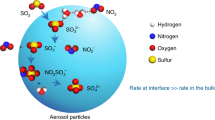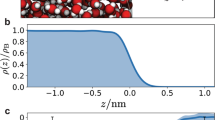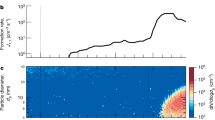Abstract
RECENTLY, Friend et al.1 reported a comprehensive laboratory study of a system of air containing trace quantities of H2O, SO2, NH3 and O3. By varying the proportions of these trace gases and the conditions of radiation of ultraviolet light and temperature, they obtained some detailed information for studying the mechanism of formation of stratospheric sulphate particles. They proposed a chemical model to interpret their laboratory observations and other observed features of stratospheric aerosol. The possible role of nitric acid, however, which is relatively abundant in the stratosphere2, was not included in their investigation of stratosphere aerosol formation. Also, the possible solid phase of 75% H2SO4 by weight in water at −50° C, as discussed by Toon and Pollack3, was not taken into consideration in their proposed chemical model to interpret the formation mechanism of ammonium sulphate or ammonium persulphate particles in the stratosphere. Toon and Pollack examined some of the physical properties of nitric acid, sulphuric acid and ammonium sulphate in stratospheric thermodynamic conditions3. Using physical equilibrium phase diagram analysis techniques4, they compared the equilibrium vapour pressure over nitric acid solutions with observed water and nitric acid partial pressures in the stratosphere, and concluded that nitric acid cannot be present as an aerosol in the lower stratosphere. For sulphuric acid, they predicted that sulphuric acid aerosol particles in the stratosphere are 75% H2SO4 by weight in water, in agreement with observations by Rosen5. From the freezing curve of H2SO4 solutions6, Toon and Pollack pointed out that H2SO4 (75% in weight)–H2O (25%) aerosol particles should exist in the lower stratosphere either as a solid or as a supercooled liquid. If most of the stratospheric sulphuric acid aerosol particles are in the solid phase, then the chemical models for the formation of ammonium sulphate using solution chemistry in sulphuric acid would not be applicable.
This is a preview of subscription content, access via your institution
Access options
Subscribe to this journal
Receive 51 print issues and online access
$199.00 per year
only $3.90 per issue
Buy this article
- Purchase on Springer Link
- Instant access to full article PDF
Prices may be subject to local taxes which are calculated during checkout
Similar content being viewed by others
References
Friend, J. P., Leifer, R., and Trichon, M., J. atmos. Sci., 30, 465 (1973).
Lazrus, A. L., Gandrud, B., and Cadle, R. D., J. appl. Meteorol., 11, 389 (1972).
Toon, O. B., and Pollack, J. B., J. geophys. Res., 78, 7051 (1973).
Lewis, J. S., Astrophys. J. Lett., 152, L79 (1968); Icarus, 10, 365 (1969).
Rosen, J. M., J. appl. Meteorol., 10, 1044 (1971).
Giauque, W. F., Hornung, E. W., Kunzler, J. E., and Rubin, T. R., J. Am. chem. Soc., 82, 62 (1960).
International Critical Tables, 4, (McGrawHill, New York, 1928).
Rubin, T. R., and Giauque, W. F., J. Am. chem. Soc., 74, 800 (1952).
Kunzler, J. E., and Giauque, W. F., J. Am. chem. Soc., 74, 5271 (1952).
Author information
Authors and Affiliations
Rights and permissions
About this article
Cite this article
KIANG, C., HAMILL, P. H2SO4-HNO3-H2O ternary system in the stratosphere. Nature 250, 401–402 (1974). https://doi.org/10.1038/250401a0
Received:
Revised:
Issue Date:
DOI: https://doi.org/10.1038/250401a0
This article is cited by
-
Facet shapes and thermo-stabilities of H2SO4•HNO3 hydrates involved in polar stratospheric clouds
Journal of Molecular Modeling (2015)
-
First measurements of gas phase sulphuric acid in the stratosphere
Nature (1980)
Comments
By submitting a comment you agree to abide by our Terms and Community Guidelines. If you find something abusive or that does not comply with our terms or guidelines please flag it as inappropriate.



